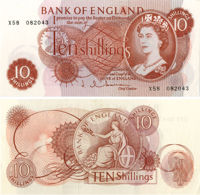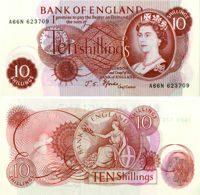020 7636 1188 info [at] coincraft.com
You have no items in your shopping cart.
Ten Shilling Notes
View as
Sort by
Display per page
J Q Hollom Portrait 10/- B294 EF/EF+
J Q Hollom 10/- Red Brown Portrait B294 Queen Eliz/ Young Britannia Crisp EF.
£8.75
J S Fforde Portrait 10/- B310 A-N Prefix AU/Unc
J S Fforde 10/- Red Brown Portrait B310 A-N prefix Unc
£12.50
J S Fforde Portrait 10/- B311 M80 Very Last Prefix Unc
In 1971 the Bank of England stopped issuing the 10 shilling note when a new 50 pence coin was introduced. As a denomination it has been introduced in 1928 and just 43 years later vanished from circulation. The last Chief Cashier to sign the 10 shilling note denomination was J S Fforde. During that time we know replacement notes were produced with the M prefix. The very last of these replacement notes had the prefix M80 (B311) They are tough to find in any grade and missing from a lot of collections. In Uncirculated finding them is even tougher.
£45.00
L K O'Brien Britannia 10/- B271 Unc
LK O’Brien was the last Chief Cashier to sign the Britannia 10 shillings. It was during his term that the Bank replaced the Britannia design with notes featuring the Queen’s Portrait. (B271) O’Brien Britannia Ten shillings available in Uncirculated.
£45.00
L K O'Brien Portrait 10/- B286 EF
L K O’Brien was Chief Cashier when the Bank of England decided to change the design of its banknotes from the Britannia series to the new Portrait series, which for the fi rst time in the bank’s long history was to feature the portrait of the reigning monarch. This issue we can off er examples of the O’Brien Portrait 10 shillings which was issued in 1960. (B286) The Portrait 10 shilling as its name implies featured a portrait of the young Queen Elizabeth II .The back retained Britannia but as a seated young girl. We can offer this note is Very Fine and Extremely Fine.
£7.50
L K O'Brien Portrait 10/- B286 VF
L K O’Brien was Chief Cashier when the Bank of England decided to change the design of its banknotes from the Britannia series to the new Portrait series, which for the first time in the bank’s long history was to feature the portrait of the reigning monarch. We can offer examples of the O’Brien Britannia 10 shillings (B271) and of the Portrait 10 shillings which replaced it in 1960. (B286) The Britannia design was introduced in 1928 under Mahon. The front featured a portrait of Britannia seated and the back a bed of acanthus leaves. The Portrait 10 shilling as its name implies featured a portrait of the young Queen Elizabeth II. The back retained Britannia but as a seated young girl. We offer Fine to Very Fine examples of the Britannia 10/- and Very Fine examples of the Portrait variety. Save when you buy the pair.
£6.25
O'Brien, 10/- Britannia red/brown, VF
Bank of England, Ten Shilling red/brown note signed by L.K. O'Brien as Chief Cashier. VERY FINE Condition
£21.50
P S Beale 10 Shillings /- 2nd Issue B266 GEF/Unc
P S Beale Bank of England 10 Shillings; featuring Red Britannia threading - B266 - Crisp Good-Extremely Fine/Uncirculated condition.
£40.00
Wartime 10 shillings
During the Second World War, the Bank of England changed the colour of its 10 shillings and £1 notes in an effort to thwart counterfeiters. The green £1 was printed in blue and pink while the 10 shillings note went from red brown to mauve.
From £39.50




































